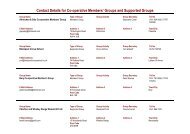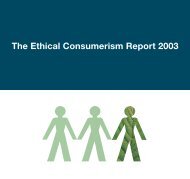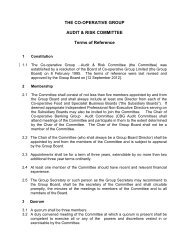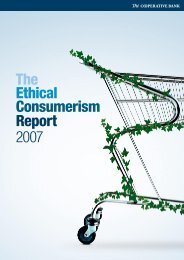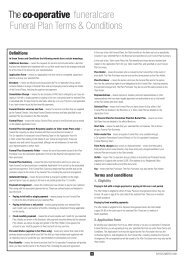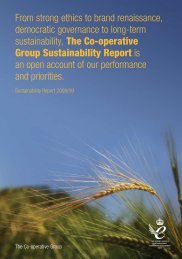Blackmail Report PDF - The Co-operative
Blackmail Report PDF - The Co-operative
Blackmail Report PDF - The Co-operative
Create successful ePaper yourself
Turn your PDF publications into a flip-book with our unique Google optimized e-Paper software.
<strong>Blackmail</strong><br />
THE FIRST IN A SERIES OF INQUIRIES INTO<br />
CONSUMER CONCERNS ABOUT THE ETHICS<br />
OF MODERN FOOD PRODUCTION AND ADVERTISING.
Overview<br />
<strong>The</strong> <strong>Co</strong>-op is committing itself to a voluntary ban on<br />
advertising, during children’s TV hours, of all food<br />
and drink products high in fat, sugar or salt.<br />
And the <strong>Co</strong>-op is calling on others in the food chain to follow this lead. At the<br />
same time it is campaigning for the Independent Television <strong>Co</strong>mmission (ITC)<br />
to impose a ban as there are likely to be many dissenters amongst the vested<br />
interests of the food industry.<br />
<strong>The</strong>se actions follow the publication of the <strong>Co</strong>-op Food Crimes <strong>Report</strong> in May 2000.<br />
In it the <strong>Co</strong>-op committed to a series of inquiries examining the evidence behind<br />
public concern about the commercialisation of food and drink. And it agreed to report<br />
back on what actions are required to restore public confidence in the food chain.<br />
This first inquiry looks into ‘<strong>Blackmail</strong>’- parental concern about the impact<br />
of TV advertising of food and drink products on their children’s diets.<br />
<strong>The</strong> findings, published here, form the basis of a submission by the <strong>Co</strong>-op to<br />
the ITC to change the rules governing advertising standards and practice.<br />
<strong>The</strong> inquiry was conducted against a background of revelations from the Food<br />
Standards Agency about a crisis in children’s diets, at a time when the ITC is<br />
undertaking a major review of its <strong>Co</strong>de of Advertising Standards and Practice,<br />
reporting back in October 2000 1 .<br />
However, the ITC consultation paper, published in May 2000, is more about the<br />
relaxation of advertising restrictions. It makes no mention of the need to<br />
review the cumulative effect of food and drink advertising. But the evidence<br />
of the <strong>Co</strong>-op inquiry suggests that, on the contrary, the UK needs tighter controls<br />
on advertising to children and that such controls would be welcomed by parents.<br />
<strong>The</strong>ir opinions are also likely to be supported by the incoming Swedish<br />
Presidency of the EU, on record as saying it intends to take action against<br />
advertising to children. All advertising to children under 12 is banned in Sweden.<br />
<strong>The</strong> inquiry looks in detail at the food and drink products advertised during<br />
children’s TV, including their nutritional value.<br />
It also analyses the psychology behind this advertising and how it is crafted<br />
to exploit children’s vulnerabilities.<br />
1
<strong>The</strong> Case for a Ban<br />
C h i l d ren are fed a continuous diet of TV commerc i a l s<br />
p romoting fatty, sugary and salty products. Indeed,<br />
according to independent research carried out on<br />
behalf of the <strong>Co</strong>-op 2 , on some children’s TV, up to 99<br />
per cent of food advertised is high in fat, sugar or<br />
salt (see Annex One).<br />
A similar report five years ago coincided with the government’s Nutrition Task<br />
Force asking the ITC to tighten up its <strong>Co</strong>de. However the results of our research<br />
clearly demonstrate that it is still not tight enough.<br />
<strong>Co</strong>nsumed in moderation, there is no evidence that fatty, sugary and salty foods pose<br />
a threat to health. But consumed in high volumes, as increasingly they appear to be,<br />
there is mounting evidence of the damaging effect they are having on children’s diets.<br />
<strong>The</strong> most recent of several reports commissioned by the government into<br />
children’s diets, <strong>The</strong> National Diet and Nutrition Survey, published by the Food<br />
Standards Agency in June 3 , demonstrates yet again that today’s children are<br />
becoming ‘hooked’on junk food. <strong>The</strong>y eat more of the sort of fatty, sugary<br />
and salty foods of which they should be eating less. <strong>The</strong>y eat less of the foods,<br />
like fresh fruit and vegetables, of which they should be eating more.<br />
<strong>The</strong> <strong>Co</strong>-op consulted child psychologist Dr Aric Sigman 4 . He believes that, contrary t o<br />
popular opinion, children do not ‘naturally’like an unbalanced diet.<br />
If left to their own intuition, they would eat a balanced diet, but they are not left<br />
to their own intuition 5 . Advertisements, and especially TV commercials,<br />
shape children’s perceptions of the product advertised through emotional<br />
associations which override intuition. Dr Sigman identifies four fundamental<br />
emotional needs or vulnerabilities exploited by TV advertisers, often with<br />
advice from other psychologists.<br />
2
<strong>The</strong>se are:<br />
■<br />
■<br />
■<br />
■<br />
THE NEED FOR NURTURE AND PROTECTION<br />
THE NEED FOR STIMULATION<br />
THE NEED FOR ROLE MODELS<br />
THE NEED FOR PEER GROUP ACCEPTANCE<br />
Dr Sigman gives examples of the techniques used by advertisers to exploit<br />
these needs (see Annex Tw o ) .<br />
As children have developed an appetite for products high in fat, sugar and salt,<br />
so they have become adept at pestering their parents to buy them. 73 per cent<br />
of children say they ask parents to buy what they see advertised - and 52 per cent<br />
admit they don’t take “no” for an answer (see Annex Three).<br />
In independent research, parents tell us they are angry with the marketing muscle<br />
that sets their own children against them. Now parents say they have had enough.<br />
Three in four (77 per cent) want to see an end to TV advertising which<br />
‘blackmails’them into buying fatty and sugary foods (see Annex Four).<br />
<strong>The</strong> <strong>Co</strong>-op is not against advertising, on TV or elsewhere. But in the interests<br />
of consumers, especially parents and children, we believe - as they do - that this<br />
particular advertising must stop.<br />
As a consumer-owned retailer, the <strong>Co</strong>-op has always been at the forefront of food<br />
issues, putting the interests of consumers first and, whenever necessary breaking ranks<br />
with the rest of the industry to campaign for changes in the law (see Annex Five).<br />
We do not claim that any individual advertisement runs contrary to the ITC <strong>Co</strong>de,<br />
which provides that advertising to children should not denigrate good nutritional<br />
practice. But our findings demonstrate that the combined impact of food and<br />
drink advertising during children’s TV viewing hours runs counter to both<br />
the government’s healthy eating guidelines and the spirit of the ITC <strong>Co</strong>de 6 .<br />
It would be unfair to ban the advertising of any one product high in fat, sugar or<br />
salt during these hours. So, we contend, the only fair way forward is to ban the<br />
advertising of any and all.<br />
We are therefore calling on the ITC to revise its <strong>Co</strong>de of Practice to ban the advertising,<br />
during children’s TV hours, of food and drink products high in fat, sugar or salt.<br />
3
Annexes<br />
1 TV Dinners<br />
(Study by Sustain)<br />
2 How Advertising<br />
Exploits Children<br />
(Dr Aric Sigman)<br />
3 What Children Say<br />
(Research by NOP/Wardle McLean)<br />
4 What Parents Say<br />
(Research by NOP/Wardle McLean)<br />
4<br />
5 Responsible<br />
Retailing and the <strong>Co</strong>-op
ANNEX 1<br />
TV Dinners<br />
What’s being served up by the advertisers<br />
Sustain: <strong>The</strong> alliance for better food and farming was commissioned to<br />
conduct a study into TV food and drink commercials targeted at children,<br />
with specific attention to:<br />
■<br />
<strong>Co</strong>mparison of advertising in children’s TV viewing<br />
hours with advertising after the nine o’clock<br />
watershed aimed at adults<br />
■<br />
Nutritional value of food advertised compared with<br />
healthy eating guidelines<br />
■<br />
Most advertised categories of food and drink products<br />
<strong>The</strong>ir study reveals the radical difference between the types of product<br />
advertised at children and those presented to adult viewers. Cakes,<br />
biscuits and confectionery, for example, constitute 24 per cent of food<br />
advertised on Saturday morning children’s TV, 46 per cent on Children’s<br />
ITV (CITV) and 53 per cent on <strong>The</strong> Big Breakfast. But on late evening TV,<br />
their combined proportion is just 13 per cent.<br />
More alarming is the analysis of the nutritional content of food and drink<br />
advertised to children. <strong>The</strong> overwhelming proportion contains high fat, high<br />
sugar or high salt - 99 per cent in the case of Saturday morning children’s TV<br />
and 95 per cent on CITV.<br />
This could hardly contrast more sharply with governmental guidelines<br />
on healthy eating.<br />
Sustain concluded that the food and drink which government experts<br />
recommend should be consumed most are in fact advertised least<br />
- if at all - during children’s viewing hours.<br />
5
Sustain recorded and analysed all TV commercials b roadcast in<br />
m i d - M a rch during the following time periods<br />
A D V E R T I S I N G<br />
CITV<br />
Sat AM TV<br />
Big Breakfast<br />
Late evening<br />
8hrs 45 Mon to Fri<br />
3.20 - 5.05pm<br />
6hrs 30<br />
10hrs Mon to Fri<br />
7 - 9am<br />
12hrs 30 Mon to Fri<br />
9 - 11.30pm<br />
During this period, food as a percentage of all commercials<br />
accounted for<br />
CITV<br />
58%<br />
SATURDAY AM<br />
BIG BREAKFAST<br />
45%<br />
48%<br />
LATE EVENING<br />
21%<br />
Number of food and drink commercials per hour<br />
7<br />
1 0<br />
9<br />
5<br />
C I T V<br />
S AT U R D AY A M<br />
B IG B REAKFA S T<br />
L AT E EV E<br />
6
Categories of food and drink products advertised<br />
CITV, SATURDAY AM & BIG BREAKFAST<br />
CAKES & BISCUITS<br />
CONFECTIONERY<br />
20%<br />
21%<br />
BREAKFAST CEREALS<br />
14%<br />
READYPREPARED FOODS<br />
12%<br />
SAUCES<br />
FAST FOOD RESTAURANTS<br />
SOFT DRINKS<br />
DAIRY<br />
8%<br />
7%<br />
6%<br />
6%<br />
FATS/SPREADS<br />
SAVOURY SNACKS<br />
HOT BEVERAGES<br />
2%<br />
1 %<br />
3%<br />
Nutritional analysis of advertised foods<br />
C I T V<br />
40 63 32 95<br />
%<br />
S AT U R D AY A M<br />
39 63 49 99<br />
%<br />
BIG BREAKFA S T<br />
30 74 27 96<br />
%<br />
L ATE EVENING 25 25 49 86 %<br />
7
What we should be eating according to the govern m e n t ’s<br />
National Food Guide<br />
What is advertised to children<br />
CITV, SATURDAY AM & BIG BREAKFAST<br />
Bread, other cereals & potatoes 34%<br />
Fruit & vegetables 33%<br />
Milk & dairy foods 15%<br />
Meat, fish & alternatives 12%<br />
Fatty & sugary foods 7%<br />
Bread, other cereals & potatoes 16%<br />
Fruit & vegetables 0%<br />
Milk & dairy foods 10%<br />
Meat, fish & alternatives 4%<br />
Fatty & sugary foods 70%<br />
8
ANNEX 2<br />
How Advertising<br />
Exploits Children<br />
by Dr Aric Sigman<br />
Advertisements directed at children are<br />
designed to address a child’s basic needs<br />
and tendencies - which are still raw and<br />
unformed - and to exploit them.<br />
Children are exposed to T V commercials during their critical stages of development,<br />
a time when parents’efforts to shape their children’s tastes and social behaviour is<br />
of paramount importance and must predominate.<br />
Advertising therefore disrupts the normal process of child rearing, intervening<br />
and subverting a child’s needs and desires when they are most vulnerable and<br />
pliable. <strong>The</strong>re are now also concerns that the short, high-stimulation nature<br />
of TV commercials for children may have permanent effects on their brain<br />
development and their attention spans. Some scientists believe that the<br />
enormous increase in Attention Deficit Disorder amongst children is the result<br />
of this type of televisual stimulation 7 .<br />
<strong>The</strong>re are four vulnerabilities exploited by advertisers<br />
■<br />
■<br />
■<br />
■<br />
THE NEED FOR NURTURE AND PROTECTION<br />
THE NEED FOR STIMULATION<br />
THE NEED FOR ROLE MODELS<br />
THE NEED FOR PEER GROUP ACCEPTANCE<br />
9
■ THE NEED FOR NURTURE AND PROTECTION<br />
Children depend on parents to make honourable and protective<br />
decisions about their well-being. This is exploited via the<br />
association of food and drink with mothers and ‘goodness’:<br />
MOTHER LOVE -A nurturing mother is seen giving her own children the sugary<br />
fatty product while mentioning terms such as “vitamins”. <strong>The</strong> wholesomeness and<br />
sanctity of motherhood is used to reassure and persuade children that the sugary or<br />
fatty product has the maternal seal of approval.<br />
MOTHER NATURE -A mother nature figure in the forest sneers while tossing her<br />
glass of drinking water aside and informs children that water tastes bad, but that<br />
this can be cured by adding fruit flavouring and colouring.<br />
■ THE NEED FOR STIMULATION<br />
Children are able to throw themselves wholeheartedly into<br />
imagined worlds of fantasy - e.g. the Tooth Fairy and Santa Claus.<br />
<strong>The</strong> enduring success of cartoon is proof of this tendency.<br />
Advertisers use the child’s imagination to great effect,<br />
exploiting his or her need for stimulation:<br />
I’M YOUR FRIEND - <strong>The</strong> product literally comes alive and speaks to the child,<br />
who is impressionable and unable to distinguish easily between an advertisement<br />
and a normal cartoon. An adult narrator uses over the top enthusiasm with<br />
plenty of connotative meaning to make it all the more authentic and exciting in<br />
the mind of the child.<br />
VIRTUAL CELEBRITY - Established cartoon or animation characters that children<br />
recognise interact with the product and endorse it. Such characters have<br />
great authority and influence in the mind of the child and lend the product<br />
tremendous credibility.<br />
1 0
■ THE NEED FOR ROLE MODELS<br />
Children are constantly in the process of developing their own<br />
identity, values and tastes. Much of this occurs through<br />
observing and imitating the role models provided - parents and<br />
relatives. However, advertisements now provide alternative role<br />
models to influence the child’s identity and tastes:<br />
HERO APPEAL - Some adverts take advantage of the tendency to ‘hero worship’.<br />
A well-known healthy sporting hero is shown to be desperate for, and crazy about,<br />
a product that his team’s nutritionist is unlikely to recommend. <strong>The</strong> narrator’s voice<br />
points out how tall and powerful the champion is and how he loves the product<br />
which he is then seen eating. Children are led to believe that the fatty,<br />
sugary product is linked to strength, health and winning.<br />
SEX APPEAL - Children are interested in glamourous adult behaviour and learn<br />
about ‘normal’male/female interaction. With this in mind, advertisers are now using<br />
sexual symbolism on screen to intrigue young children.<br />
■ THE NEED FOR PEER GROUP ACCEPTANCE<br />
Being highly susceptible to social influence, children like to<br />
conform to what they see as the desirable group norm:<br />
especially what is ‘cool’. <strong>The</strong>y will change their behaviour,<br />
tastes and language to fit in:<br />
STREET CRED - Rapper street culture is used to lend street credibility to products.<br />
Suburban girls grasp the product adoringly and exclaim “wicked!”, while boys attract<br />
their interest through aggressive macho behaviour.<br />
JUNIOR JONESES - Children are always comparing themselves to others and<br />
what others have. <strong>The</strong>y often collect things and compete. Adverts focus on free<br />
collectable toys (“collect the entire set!”) some with scenes of nature and animals<br />
as the main focus, as opposed to the fatty, sugary products with additives<br />
that are really being advertised.<br />
11
ANNEX 3<br />
What Children Say<br />
<strong>The</strong> <strong>Co</strong>-op commissioned NOP and<br />
Wardle McLean in March 2000 to research<br />
children’s responses to TV commercials.<br />
<strong>The</strong> research found that all children believe advertising is a promise of superior<br />
quality. Older children appear to value it highly as a source of information which<br />
guides their purchases.<br />
<strong>The</strong> offer of a collectable was a powerful inducement to seek out the product.<br />
Meanwhile the reality of ‘pester power’ was outlined in the result that 73 per cent<br />
of children asked parents to buy something they had seen on TV - with only two in<br />
10 giving up or doing nothing when confronted with a parental “no”.<br />
Children’s responses to advertising of sweets & crisps<br />
SAMPLE ALLCHILDREN<br />
5% 3% 73%<br />
Ask parent to buy it<br />
8%<br />
Save pocket money to buy it<br />
Just go out and buy it<br />
11%<br />
Ask a friend whether they have<br />
tried them<br />
Not interested<br />
1 2
Children who have bought something to get a free gift or<br />
collect tokens towards one<br />
SAMPLE ALLCHILDREN<br />
71%<br />
Yes<br />
28%<br />
Don’t know<br />
No<br />
1%<br />
Children’s responses to answer “no”<br />
SAMPLE ALLCHILDREN<br />
5% 29%<br />
Pester/ask again until they give in<br />
10%<br />
Save up pocket money to get it myself<br />
Give up/do nothing<br />
Get upset<br />
17%<br />
25%<br />
Other<br />
Cry<br />
19%<br />
1 3
ANNEX 4<br />
What Parents Say<br />
<strong>The</strong> <strong>Co</strong>-op commissioned NOP and Wardle McLean<br />
in March 2000 to research parents’ attitudes to<br />
TV commercials and how they managed their<br />
children’s requests for products advertised.<br />
Parents told us they were angry with food and drink advertisers who target their<br />
children with sugary and fatty products, fanning the flames of ‘pester power’,<br />
setting child against parent.<br />
More than eight in 10 said they wanted to see tighter controls on<br />
advertising to children.<br />
Three in four (77 per cent) want to see a ban on the advertising of such<br />
products to their children.<br />
Attitudes towards advertising to children<br />
SAMPLE ALLADULTS<br />
Advertising sugary/fatty foods should be<br />
banned during children’s programmes<br />
56 21 7 9 3 4<br />
%<br />
All advertising aimed at children should be<br />
banned during children’s programmes<br />
36 19 12 21 8 4<br />
%<br />
All advertising must avoid<br />
making unjustified health claims<br />
73 16 3 2 - 6<br />
%<br />
<strong>The</strong>re should be stricter rules about<br />
advertising to children<br />
67 18 4 4 1 5<br />
%<br />
1 4
<strong>The</strong> methods of persuasion<br />
SAMPLE ALLADULTS<br />
Free toy or gift<br />
68% 17% 5% 6% 5%<br />
Claims of how healthy product is<br />
12% 21% 22% 40% 6%<br />
Association with cool, fashionable people<br />
32% 30% 15% 18% 6%<br />
Association with characters<br />
65% 17% 8% 5% 5%<br />
In store display<br />
37% 31% 17% 10% 5%<br />
Promotion of web site<br />
7% 12% 11% 36% 34%<br />
Very persuasive Quite persuasive Not very persuasive<br />
Not at all persuasive<br />
Don’t know<br />
If we don’t get it for them then we are bad,<br />
“we are cruel, we are the misers.<br />
”<br />
“<br />
I don’t want them to hassle me in the<br />
supermarkets... I want my children to grow up<br />
sensibly and not be led by the advertisers.<br />
”<br />
“ ”<br />
My kids are being teased about what I give them.<br />
I give them ordinary things like a ham sandwich.<br />
“<br />
If you have a two-year-old lying on the<br />
ground and a five-year-old screaming, I just<br />
give in, I just want to get out of the shop.<br />
”<br />
Looking at the advert, lovely orange juice from sunny<br />
Florida. Very good for the kids. It’s not. It’s squash.<br />
“ ”<br />
1 5
ANNEX 5<br />
Responsible Retailing<br />
& the <strong>Co</strong>-op<br />
<strong>The</strong> responsible retailing campaign was launched in<br />
1995 after the biggest ever survey of consumer views.<br />
More than 30,000 people responded and the message was clear: shoppers want to<br />
make informed purchasing decisions based on concerns about animal welfare, the<br />
environment and human rights.<br />
In response the <strong>Co</strong>-op pledged to give consumers the full facts on products,<br />
including details of who makes <strong>Co</strong>-op Brand products. A Right to Know policy<br />
was implemented to provide consumers with the facts they need to make informed<br />
purchasing decisions.<br />
<strong>The</strong> <strong>Co</strong>-op has a democratic base of individual members. Each member has an<br />
individual vote no matter how much money they have invested in the <strong>Co</strong>-op.<br />
<strong>The</strong>y belong to the <strong>Co</strong>-<strong>operative</strong> Movement because they believe in a wide range<br />
of consumer and social issues. As a unique consumer-owned retailer the <strong>Co</strong>-op<br />
has a duty to serve consumers, not industry or the City.<br />
<strong>The</strong> <strong>Co</strong>-op has always been at the forefront of retailing issues, leading industry and<br />
interpreting the law in the best interest of the consumer. Among its campaigns are:<br />
1995 RESPONSIBLE RETAILING -A report based on the UK’s largest ever<br />
independent survey of ethical concerns<br />
1995 THE PLATE OF THE NATION -A report on the national diet<br />
1996 ENDING THE PAIN - Finding a solution to stop animal testing<br />
1997 LIE OF THE LABEL -A report calling for honest labelling<br />
1998 JURY’S VERDICT - <strong>Report</strong>ing on complaints and adjudications<br />
under the <strong>Co</strong>-op’s code of labelling practice<br />
1999 BREAKING THE BARRIERS - <strong>Co</strong>-operating for social inclusion<br />
2000 FOOD CRIMES - Launching a series of inquiries into the<br />
ethics of modern food production<br />
1 6<br />
<strong>The</strong> <strong>Co</strong>-op has broken ranks with the rest of the industry when it has been in the<br />
interest of the consumer and, if necessary, it will continue to do so in the future.
ENDNOTES<br />
1 In a consultation paper, published on<br />
8 May 2000, the ITC initiated a review<br />
of its advertising rules, starting with a<br />
reassessment of all specific prohibitions<br />
set out in its <strong>Co</strong>de of Advertising Standards<br />
and Practice. Interested parties were invited<br />
to submit evidence by 7 July 2000.<br />
2 Research undertaken by Sustain:<br />
<strong>The</strong> alliance for better food and farming<br />
3 National Diet and Nutrition Survey: Young<br />
People Aged 4-18 years, published by the<br />
Food Standards Agency on 1 June 2000,<br />
was commissioned by the Ministry of<br />
Agriculture, Fisheries and Food and the<br />
Department of Health and was undertaken<br />
by the Office for National Statistics,<br />
Medical Research <strong>Co</strong>uncil Human Nutrition<br />
Research, and the Dental Schools of the<br />
Universities of Newcastle upon Tyne and<br />
of Birmingham. <strong>The</strong> survey forms part of<br />
the National Diet and Nutrition Survey<br />
programme, which gathers information<br />
about the dietary habits and nutritional<br />
status of the British population.<br />
4 Dr Aric Sigman AFBPSis a Chartered<br />
Psychologist and Chartered Biologist.<br />
He has headed health education campaigns<br />
on behalf of the Department of Health on<br />
smoking, depression and suicide risk.<br />
He acted as advisor to the Institute of<br />
Personnel Management for five years.<br />
As a broadcaster, Dr Sigman has<br />
worked on children’s TV programmes.<br />
He also wrote and presented a<br />
Dispatches documentary ‘Dying to Diet’,<br />
which exposed the link between dieting<br />
and shorter life spans.<br />
Dr Sigman won <strong>The</strong> Times Education<br />
Supplement Best Non-fiction Award in<br />
1993 for his book Getting Physical, a<br />
teenage health guide. <strong>The</strong> book called into<br />
question the methods used to advertise<br />
food to children.<br />
5 Evidence from USFederal Government<br />
Department of Agriculture Summit on<br />
Nutrition and Health, held in Washington DC<br />
in June 2000, at which officials suggested a<br />
sophisticated marketing counter-attack,<br />
pitting commercials promoting the<br />
appeal of ‘healthy’ foods against<br />
those showing ‘unhealthy’ foods.<br />
6 ITC<strong>Co</strong>de of Advertising Standards and<br />
Practice Section 36 Food Advertising<br />
G e n e r a l Note: Public health policy<br />
(for example, 1992 White Paper ‘<strong>The</strong> Health<br />
of the Nation’) places increasing emphasis<br />
on good dietary behaviour as a means for<br />
preventing illness and promoting health.<br />
<strong>Co</strong>mpetitive product advertising cannot<br />
reasonably be expected to perform the<br />
same role as education and public<br />
information in promoting a varied and<br />
balanced diet. At the same time it is<br />
i m p o r t a n tthat such advertising should<br />
not undermine progress towards national<br />
dietary improvement by misleading or<br />
confusing customers or by setting bad<br />
examples, particularly to children.<br />
<strong>The</strong> following rules apply to all<br />
advertising for foods and food products<br />
and, in the case of advertising addressed<br />
to children, are to be interpreted in<br />
conjunction with the rules in Appendix 1.<br />
(a) Advertisements must not encourage<br />
or condone excessive consumption<br />
of any food.<br />
(b) Advertisements must not disparage<br />
good dietary practice and any<br />
comparisons between foods must not<br />
discourage selection of foods such as<br />
fresh fruit and vegetables which current<br />
generally accepted dietary opinion<br />
recommends should form a greater<br />
part of average diet.<br />
(c) Advertisements, particularly those<br />
addressed to children, must pay regard<br />
to consideration of oral health.<br />
7 Dr Jane M Heal in Failure to <strong>Co</strong>nnect,<br />
1999, Simon & Schuster, believes<br />
that children’s attention spans are<br />
harmed by multi-media distractions.<br />
Studies have found that a reduction<br />
in stimulation leads to enhanced<br />
creativity, problem solving, alertness and<br />
even musical creativity and performance<br />
(Atkinson, R. Short-Term Exposure to Rest:<br />
Enhancement Performance on a<br />
For further information:<br />
Please write to CWS Ltd, Freepost MR9 473, Manchester M4 8BA,<br />
visit our website at www.co-op.co.uk or call us free on 0800 0686727<br />
<strong>The</strong> <strong>Co</strong>-op commissioned market research by NOP <strong>Co</strong>nsumer who interviewed 1,216 adults<br />
(523 of whom were parents) and 293 children under 11 years old. Group discussions were also<br />
conducted by Wardle McLean Strategic Research <strong>Co</strong>nsultancy with adults (including parents)<br />
and children under 11 years old. <strong>The</strong> research was conducted in February and March 2000.<br />
Sustain: <strong>The</strong> alliance for better food and farming carried out research in mid-March 2000, analysing 272<br />
ads for food and soft drinks shown during 37 hours and 35 minutes of TV. <strong>The</strong>se advertisements were<br />
aired during the following times: weekdays 7-9am; 3.20-5.05pm; 9-11pm and Saturday morning TV.<br />
Published July 2000. CWS Ltd, New Century House, Manchester M60 4ES. Printed on recycled paper.



